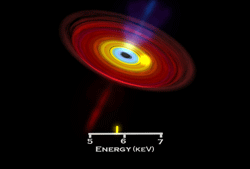
|
Click on image to
view 2.5 MB animation.
(Credit: NASA/Dana Berry, Skyworks Digital)
|
AUDIO:
An audio signal rises in frequency as the blob comes toward you and falls
in frequency as it moves away from you.
VIDEO:
This animation illustrates how scientists track the motion of material
around a black hole by observing the Doppler shift of spectral
lines.
First we see one blob of material. On the graph we see the energy of
an emission line emitted from this material. Note how the energy emitted from
this material rises to about 6.5 KeV as it moves toward us and then
falls to about 5.8 keV as it moves away. This is the Doppler effect -
as matter moves around the black hole it is coming toward us and away
from us, causing its observed energy to rise and fall. About 14
seconds into the animation, a second blob appears further out from the
balck hole. Its energy does not vary as much as the first because it
is moving more slowly.


